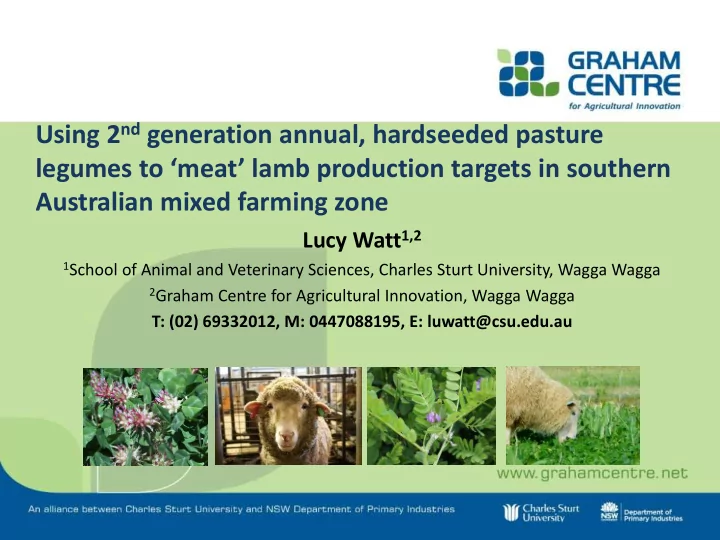

Using 2 nd generation annual, hardseeded pasture legumes to ‘ meat ’ lamb production targets in southern Australian mixed farming zone Lucy Watt 1,2 1 School of Animal and Veterinary Sciences, Charles Sturt University, Wagga Wagga 2 Graham Centre for Agricultural Innovation, Wagga Wagga T: (02) 69332012, M: 0447088195, E: luwatt@csu.edu.au
Overview Annual regenerating pasture legumes in southern Australian mixed farming (wheat-sheep) zones Most commonly used species • Subterranean clover ( Trifolium subterranean L.) • Medic spp. ( Medicago spp.) Climatic, edaphic and biological constraints • Lucerne ( Medicago sativa L.) – perennial legume
Overview 2 nd generation alternative, self-regenerating annual pasture legumes 1. Arrowleaf clover ( Trifolium vesiculosum Savi) 2. Biserrula ( Biserrula pelcinus L.) 3. Bladder clover ( Trifolium spumosum L.) 4. Gland clover ( Trifolium glandiferum Boiss) 5. French serradella ( Ornithopus sativus Brot) 3 5 1 2 4 Wide spread adaptation to Australian mixed farming systems with multi-purpose roles (ruminant production and provision of N in mixed farming systems)
Overview 2 nd generation alternative, self-regenerating annual pasture legumes • Deep rooting systems Ability to remain green and productive in very dry conditions o Sub clover Biserrula F. serradella Arrowleaf 0 0.5 1 1.5 2 2.5 Rooting depth (m) Source: Adapted from Carr et al. 1999
Overview 2 nd generation alternative, self-regenerating annual pasture legumes • High herbage production (kg DM/ha) 3000 Herbage Production (kg DM/ha) 2500 2000 1500 1000 500 0 Subterranean clover cv. French serradella cv. Biserrula cv. Casbah Seaton Park Margurita Source: Adapted from Hackney et al. 2013
Overview 2 nd generation alternative, self-regenerating annual pasture legumes • High/comparable nutritive values to traditional spp. o Ability to maintain nutritional value later into the season Biserrula 30 90 Sub clover 80 Digestibility (DOMD %) 25 70 Crude protein (%) 20 60 50 15 40 30 10 20 5 10 0 0 14/10/2011 28/10/2011 11/11/2011 25/11/2011 9/12/2011 23/12/2011 6/01/2012 20/01/2012 14/10/2011 28/10/2011 11/11/2011 25/11/2011 9/12/2011 23/12/2011 6/01/2012 20/01/2012 Source: Adapted from Hackney et al. 2012
Overview 2 nd generation alternative, self-regenerating annual pasture legumes • High/comparable nutritive values to traditional spp. o Ability to maintain nutritional value later into the season Biserrula 16 Sub clover Metabolisable energy (MJ/kg DM) 14 12 10 8 6 4 2 0 14/10/2011 28/10/2011 11/11/2011 25/11/2011 9/12/2011 23/12/2011 6/01/2012 20/01/2012 Source: Adapted from Hackney et al. 2012
Overview 2 nd generation hard-seeded, self-regenerating annual pasture legumes • A wide range of agronomic studies undertaken in various regions throughout Australia (e.g. Hackney et al. 2012; 2015) – Increased adoption of these species in the 400-650 mm mixed farming zone, principally for use in cropping rotations • In more recent years, livestock producers have begun to introduce these species into their pasture mixes as forages for grazing livestock • The expected impact on livestock production, both as grazed and conserved forages is largely unknown ?
Utilising second generation legumes as conserved forages Why is it important? • Utilisation of pasture growth in spring rarely exceeds 30% in this region (Kaiser et al ., 2006) • Feed gaps are common in the summer , autumn and often winter • Conservation of excess spring growth would provide an alternative to: X 1. Purchasing supplementary feed 2. Untimely sale of livestock $$$
Utilising second generation legumes as conserved forages Merino lambs (9-10 months) Hay Diets (sourced from Riverina) • Arrowleaf clover (cv. Cefalu) late vegetative (80 cm tall) • Bladder clover (cv. Bartolo) 40% flowering (40 cm tall) • Subterranean clover (cv. Mt Barker) not assessed Measurements • Liveweight gain (g/head/day) • Dry matter intake • Organic matter digestibility
Utilising second generation legumes as conserved forages 249 g/d 300 a 204 g/d 182 g/d Liveweight change (g/head/d) 250 ab b 200 150 100 50 0 Arrowleaf Bladder Sub
Utilising second generation legumes as conserved forages Table 1. Average crude protein (CP), metabolisable energy (ME), in vivo organic matter digestibility (OMD) and lamb DMI and LWG of the arrowleaf clover, bladder clover and subterranean clover hays. CP ME In vivo DMI LWG (%) (MJ/kg DM) OMD (kg/d) (g/d) (%) 204 ab Arrowleaf Cl. 15.8 9.8 67.6 1.34 249 a Bladder Cl. 20.4 10.3 72.9 1.50 182 b Sub Cl. 15.6 9.0 65.3 1.31
Exploring alternative options for grazable pastures – which legume performs best? September – November 2015 Merino and XB Lambs Pastures • Arrowleaf clover (cv. Arrotas) • Bladder clover (cv. Bartolo) • Biserrula (cv. Casbah) • Lucerne (cv. Sardi) • Lucerne/phalaris (cv. Advanced AT) Stocked according to the carrying capacity of the pasture • Seed set • Pasture production (biomass)
Exploring alternative options for grazable pastures – which legume performs best? Table 2. Average carrying capacity of the legume and legume-grass pastures throughout the 2015 grazing trial. Carrying capacity (sheep/ha) Arrowleaf 21.5 Biserrula 16.2 Bladder 15.1 Lucerne 27.1 Lucerne-phalaris 31.8 NB. The carrying capacity set was based on feed availability and stage of growth in the annual pasture legumes to manage for seed set and subsequent year regeneration
Exploring alternative options for grazable pastures – which legume performs best? Spring 2015 (Sept-Nov) 200 Liveweight change (g/head/d) 180 160 140 120 100 80 60 40 20 0 Arrowleaf Biserrula Bladder Lucerne Lucerne/phalaris
Exploring alternative options for grazable pastures – which legume performs best? What is the value in $/ha? $/ha * Arrowleaf clover 475.34 Biserrula 295.29 Bladder clover 307.21 Lucerne 414.30 Lucerne-phalaris 366.49 *2.80/kg used to calculate value of liveweight gain
Conclusions • Equivalent or greater potential than traditional pasture species • High liveweight gains Lambs of Merino and XB breeds • High nutritive value • High spring pasture productivity
Thank you to Meat and Livestock Australia and Australian Wool Innovation for funding this research
Recommend
More recommend